Table of Contents
Introduction
According to Golf Ball Statistics, a Golf ball is an essential part of golf, designed with a core for initial velocity and a cover for feel and durability.
Cores are typically synthetic rubber or resin, influencing distance, while covers, commonly Surlyn or urethane, affect spin and control.
Dimples on the surface minimize drag and enhance flight stability. Golf balls come in two main types: two-piece for distance and durability and multi-layer for enhanced spin and feel.
Regulations by bodies like the USGA ensure fairness. Choosing a ball depends on skill level and course conditions. With beginners favoring distance and durability and advanced players valuing spin and feel.
Editor’s Choice
- The global golf ball market revenue is projected to reach USD 1.357 billion by 2032.
- The global golf ball market is dominated by several key players. Callaway Golf Co. leading the market with a 21% share.
- As of the latest data, leisure applications dominate the market, accounting for 65% of the total market share. This reflects the widespread popularity of golf as a recreational activity among amateur and casual players.
- The global golf ball market is geographically segmented, with North America holding the largest market share at 35.0%.
- In 2022, the global golf ball export market was led by Chinese Taipei. Which exported golf balls valued at USD 295 million, accounting for 31.3% of the total export share.
- In 2022, the United States dominated the global golf ball import market with a total import value of USD 350 million, accounting for 37.1% of the market share.
- Golf ball regulations are primarily governed by the United States Golf Association (USGA) and the Royal and Ancient Golf Club of St Andrews (R&A), ensuring consistency and fairness in the sport globally.
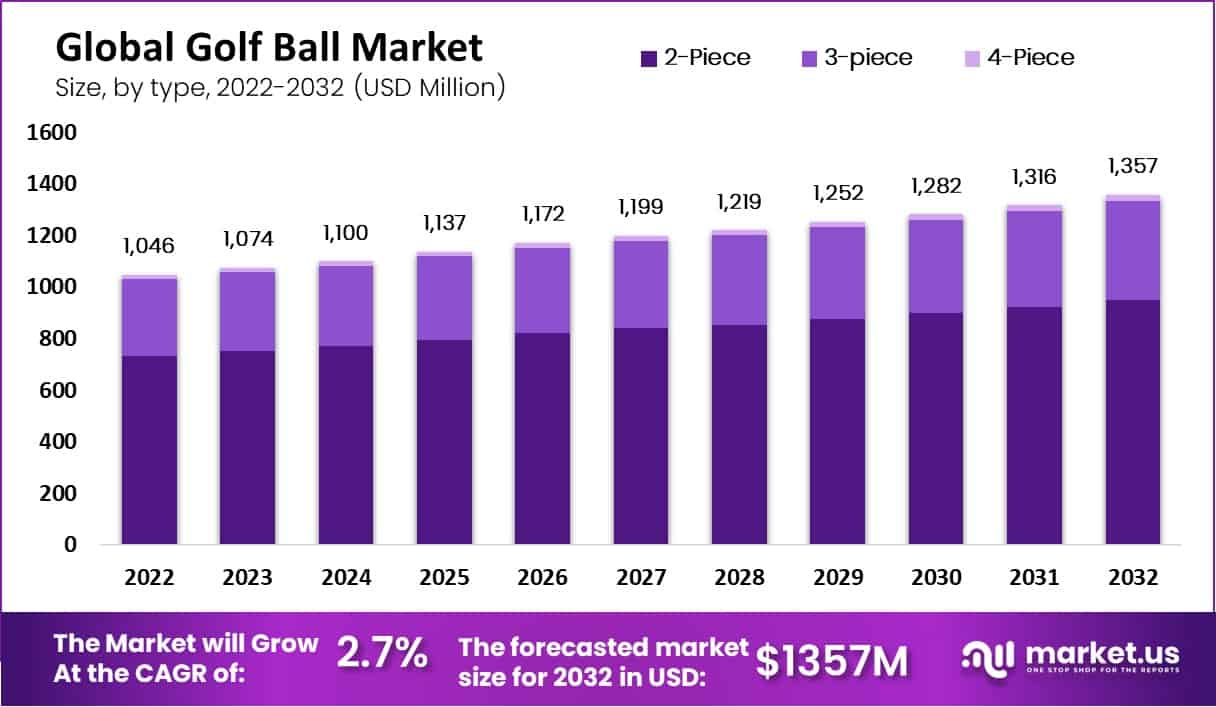
Global Golf Ball Market Overview
Global Golf Ball Market Size
- The global golf ball market has grown steadily in recent years at a CAGR of 2.70%, with revenue reaching USD 1.046 billion in 2022.
- By 2032, the global golf ball market is expected to achieve a significant milestone with revenues of USD 1.357 billion.
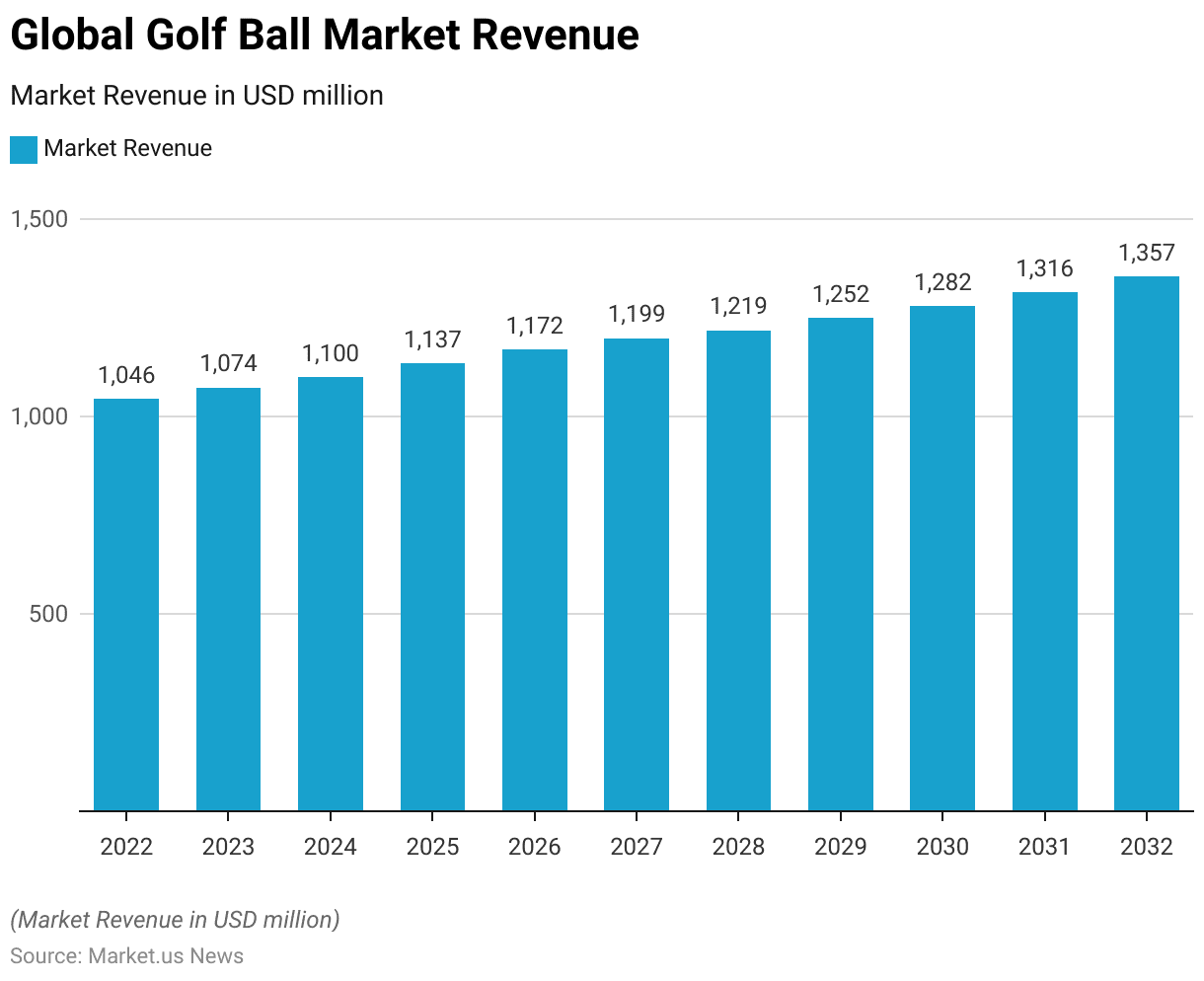
Competitive Landscape of the Global Golf Ball Market
- The global golf ball market is dominated by several key players. Callaway Golf Co. leading the market with a 21% share.
- Nike Golf, Inc. holds a significant portion as well, accounting for 14% of the market.
- TaylorMade Golf Co., Inc. follows closely with a 17% market share.
- Dixon Golf, Inc. and Mizuno. At the same time, each captures 10% and 9% of the market. Respectively, Bridgestone Golf, Inc. also holds a 9% share.
- Sumitomo Rubber Industries Ltd commands 6% of the market, and OnCore Golf Technology Inc. possesses a 4% share.
- The remaining 10% of the market is distributed among other key players.
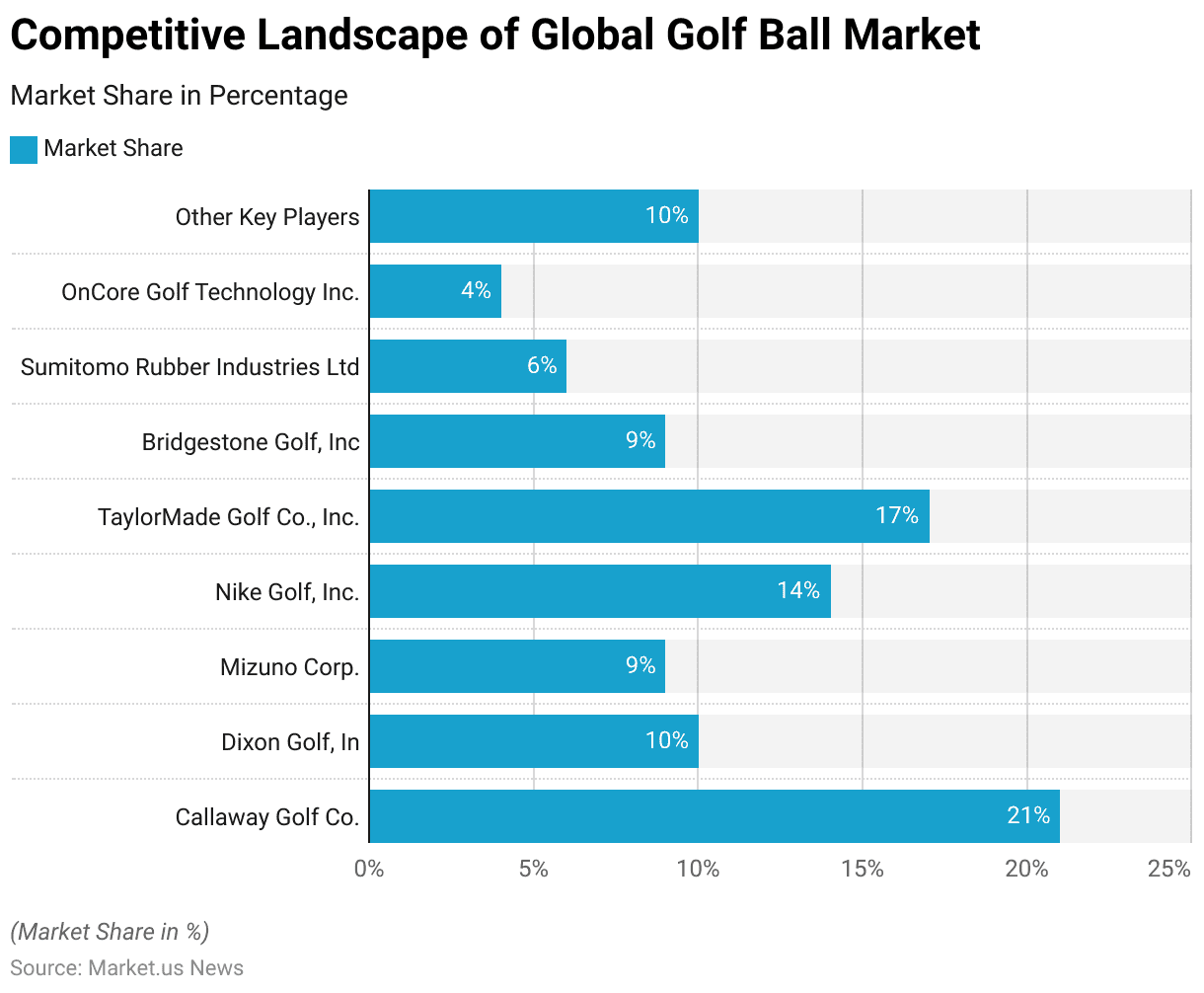
Golf Ball Specifications
- Golf balls are crafted to meet specific performance criteria, and their specifications include various parameters that influence their playability.
- Typically, a standard golf ball has a diameter of 1.68 inches (42.67 mm) and a maximum weight of 1.62 ounces (45.93 grams) as per the Rules of Golf. The core of the ball can be made of materials like rubber or synthetic polymers. It is designed to optimize energy transfer and affect compression and distance.
- Golf balls can be two-piece, three-piece, or even more complex in structure. With multiple layers aimed at improving distance, spin, and control.
- The cover of the ball is often made from materials like urethane or surlyn. Features a dimple pattern that affects aerodynamics, influencing the ball’s flight path and stability.
- For instance, the Titleist Pro V1, a popular model, has a three-piece construction with a urethane elastomer cover and 388 dimples designed for a lower trajectory and a softer feel.
Golf Players Statistics
Number of Golfers – By Country
- In 2021, the number of registered golfers across various European countries highlighted the sport’s popularity and its distribution per golf course.
- The United Kingdom led with 933,076 registered golfers, averaging 301 registered golfers and 1,688 total golfers per course.
- Sweden had 538,962 registered golfers, with 829 registered golfers and 923 total golfers per course.
- In the Netherlands, there were 407,302 registered golfers, with the highest density of 1,164 registered golfers and 1,314 total golfers per course.
- France recorded 402,991 registered golfers, averaging 497 registered golfers and 986 total golfers per course.
- Spain had 270,040 registered golfers, with 548 registered golfers and 609 total golfers per course.
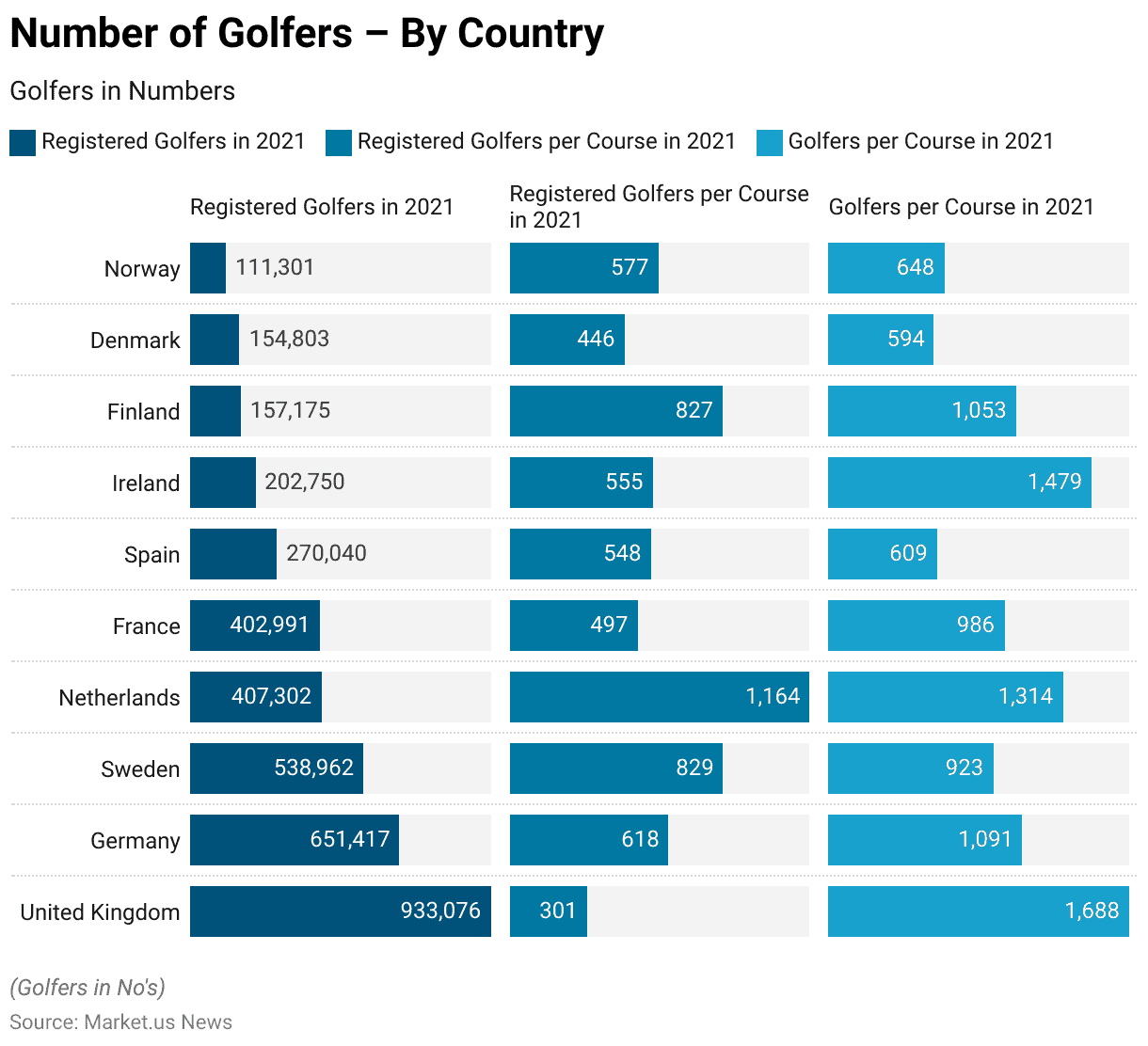
Golf Ball Companies Statistics
Revenue of Selected Golf Equipment/Apparel Companies Worldwide
Acushnet
- From 2012 to 2023, Acushnet has demonstrated significant revenue growth in the golf equipment and apparel market.
- In 2012, Acushnet reported revenues of USD 1,477.22 million, while Topgolf Callaway Brands generated USD 834.07 million.
- The company continued its upward trajectory with revenues of USD 1,681.36 million in 2019 and USD 1,612.17 million in 2020 before surging to USD 2,147.93 million in 2021, USD 2,270.34 million in 2022, and reaching USD 2,382.00 million in 2023.
Topgolf Callaway Brands
- Topgolf Callaway Brands also experienced notable growth, with revenues of USD 842.80 million in 2013. Increasing to USD 843.80 million in 2015 and USD 871.20 million in 2016.
- The following years saw remarkable growth, with revenues skyrocketing to USD 3,133.40 million in 2021, USD 3,995.70 million in 2022, and an impressive USD 4,284.80 million in 2023.
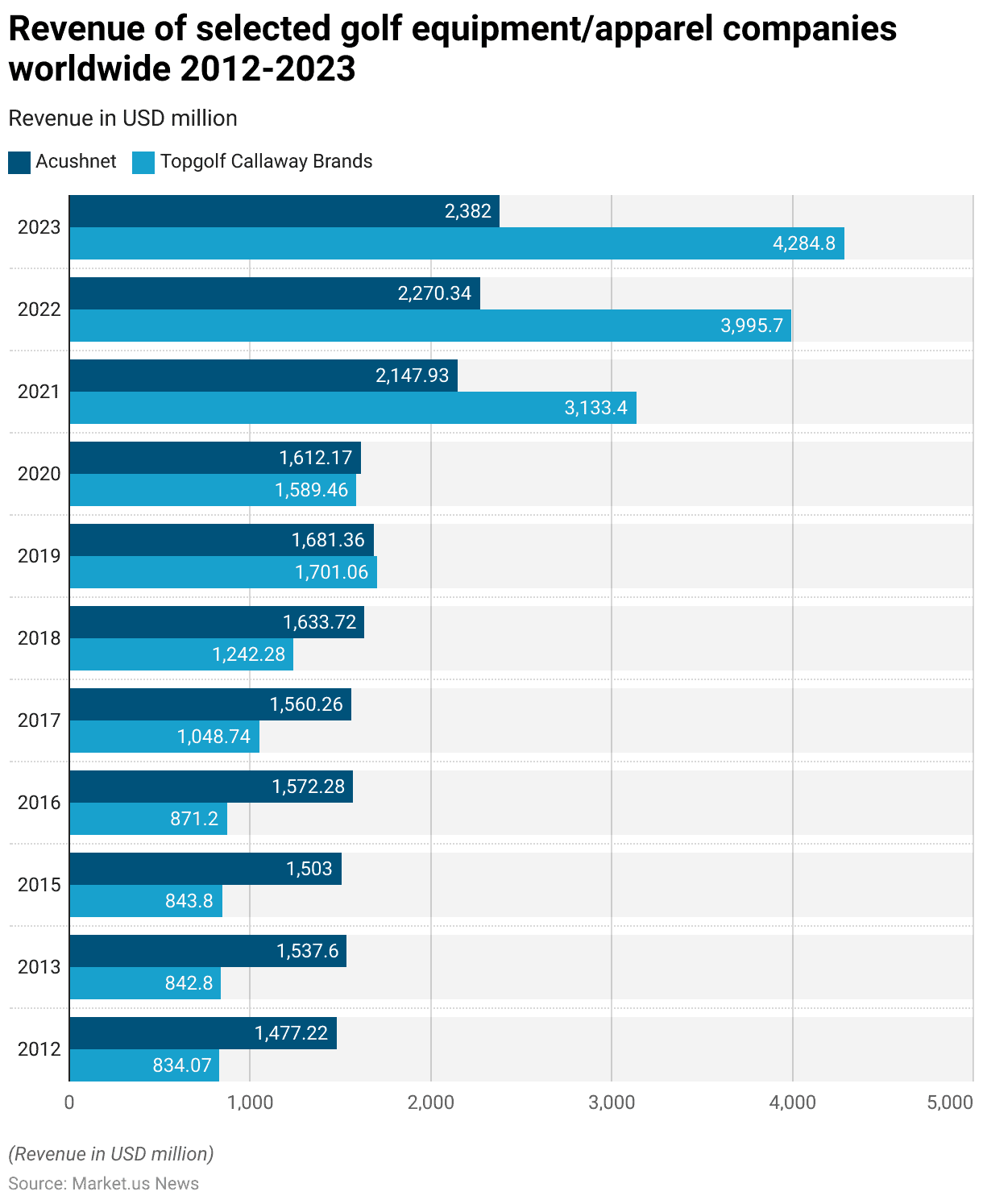
Golf Ball Export Statistics
Top Golf Ball Exporting Nations
- In 2022, the global golf ball export market was led by Chinese Taipei. Which exported golf balls valued at USD 295 million, accounting for 31.3% of the total export share.
- However, The United States followed with exports worth USD 165 million, representing 17.5% of the market share.
- China and Thailand both made significant contributions, with export values of USD 126 million (13.3%) and USD 125 million (13.2%), respectively.
- South Korea exported golf balls worth USD 39.3 million. Capturing 4.16% of the market share, while Indonesia’s exports totaled USD 35.2 million, or 3.74%.
- Vietnam exported USD 30.6 million worth of golf balls, constituting 3.24% of the market share.
- The Netherlands, Japan, and the United Kingdom also played notable roles, with export values of USD 25.1 million (2.66%), USD 23.7 million (2.51%), and USD 18.7 million (1.98%), respectively.
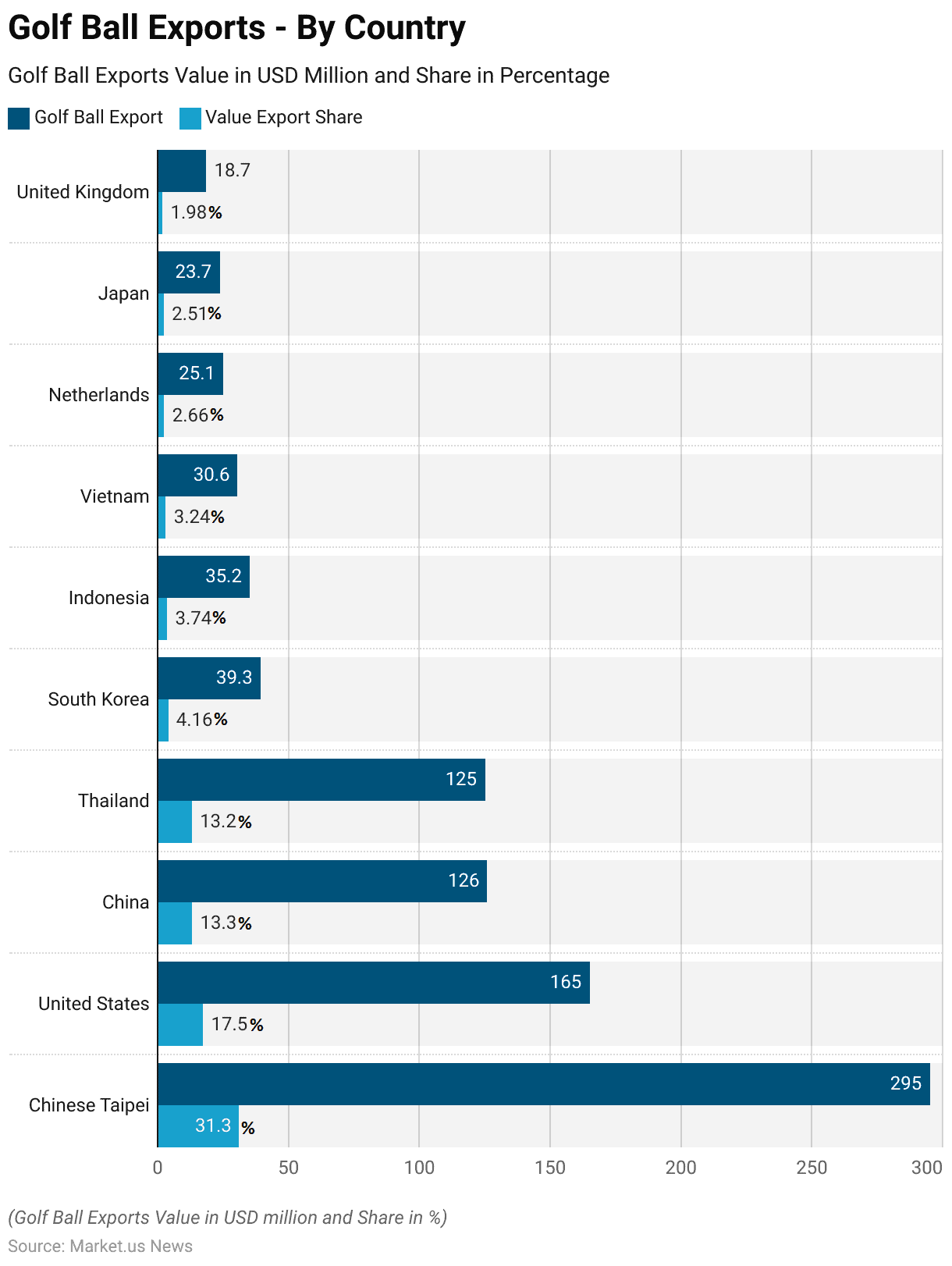
Golf Ball Import Statistics
Top Golf Ball Importing Nations
- In 2022, the United States dominated the global golf ball import market with a total import value of USD 350 million, accounting for 37.1% of the market share.
- Moreover, South Korea followed, importing golf balls worth USD 101 million, which represented 10.7% of the market.
- Japan imported golf balls valued at USD 86.3 million, capturing 9.16% of the market share, while the United Kingdom’s imports stood at USD 82.2 million, or 8.72%.
- Canada imported USD 60.6 million worth of golf balls, making up 6.43% of the market.
- Germany and the Netherlands imported USD 36.6 million (3.88%) and USD 33 million (3.5%), respectively.
- Australia imported golf balls worth USD 27.8 million, representing 2.95% of the market share, while Mexico’s imports totaled USD 15.7 million (1.66%).
- Sweden had an import value of USD 12.9 million, accounting for 1.37% of the market.
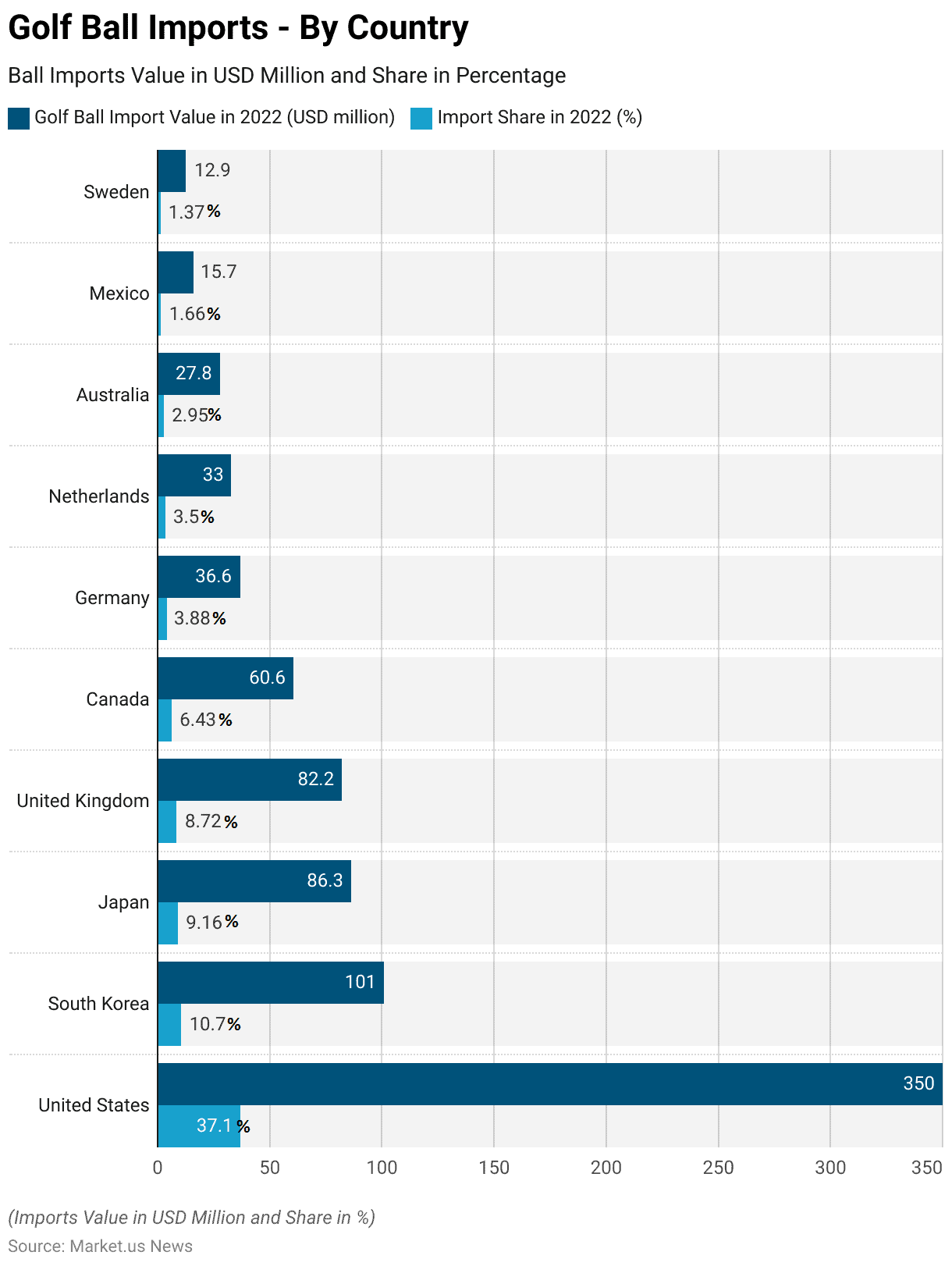
Golf Ball Sales Compared to Other Golf Accessories
Topgolf Callaway Brands Corp.’s Net Sales Worldwide – By Product Category
- From 2017 to 2023, Topgolf Callaway Brands Corp. experienced substantial growth in net sales across various product categories.
- In 2017, the company reported net sales of USD 643.1 million for golf clubs, USD 162.5 million for golf balls, USD 61.1 million for apparel, and USD 182 million for gear, accessories, and other products.
- In 2023, the company reported slight variations, with the golf club’s sales at USD 1,073.5 million, golf balls at USD 314 million, apparel at USD 713.2 million, and gear, accessories, and other products at USD 423.1 million.
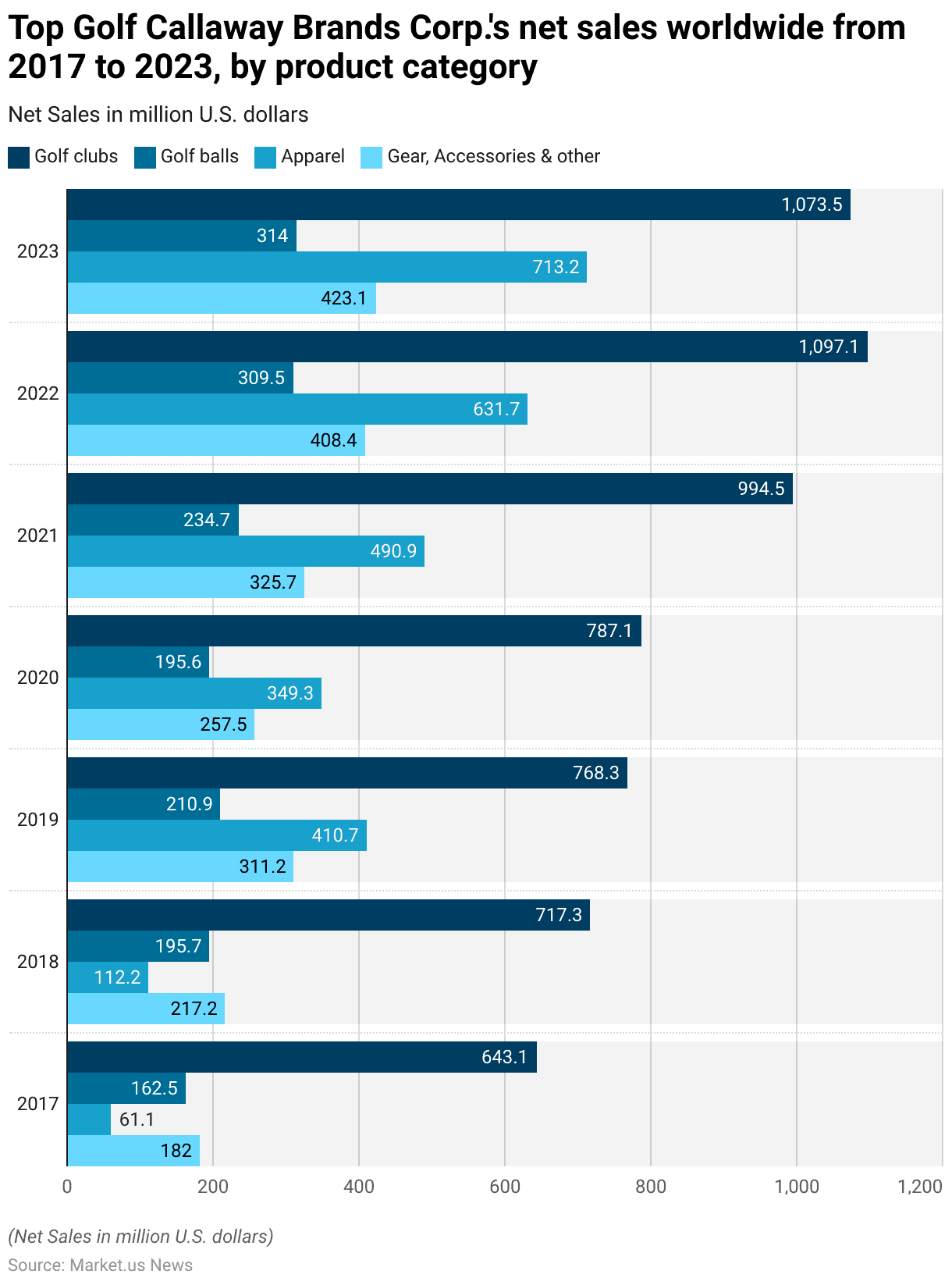
Key Spending/Investments
Global Spending On Golf Sponsorships
- From 2010 to 2016, worldwide sponsorship spending for golf experienced a consistent upward trend.
- In 2010, the total sponsorship spending was USD 1.36 billion.
- The upward trajectory culminated in 2016, with sponsorship spending reaching USD 1.82 billion.
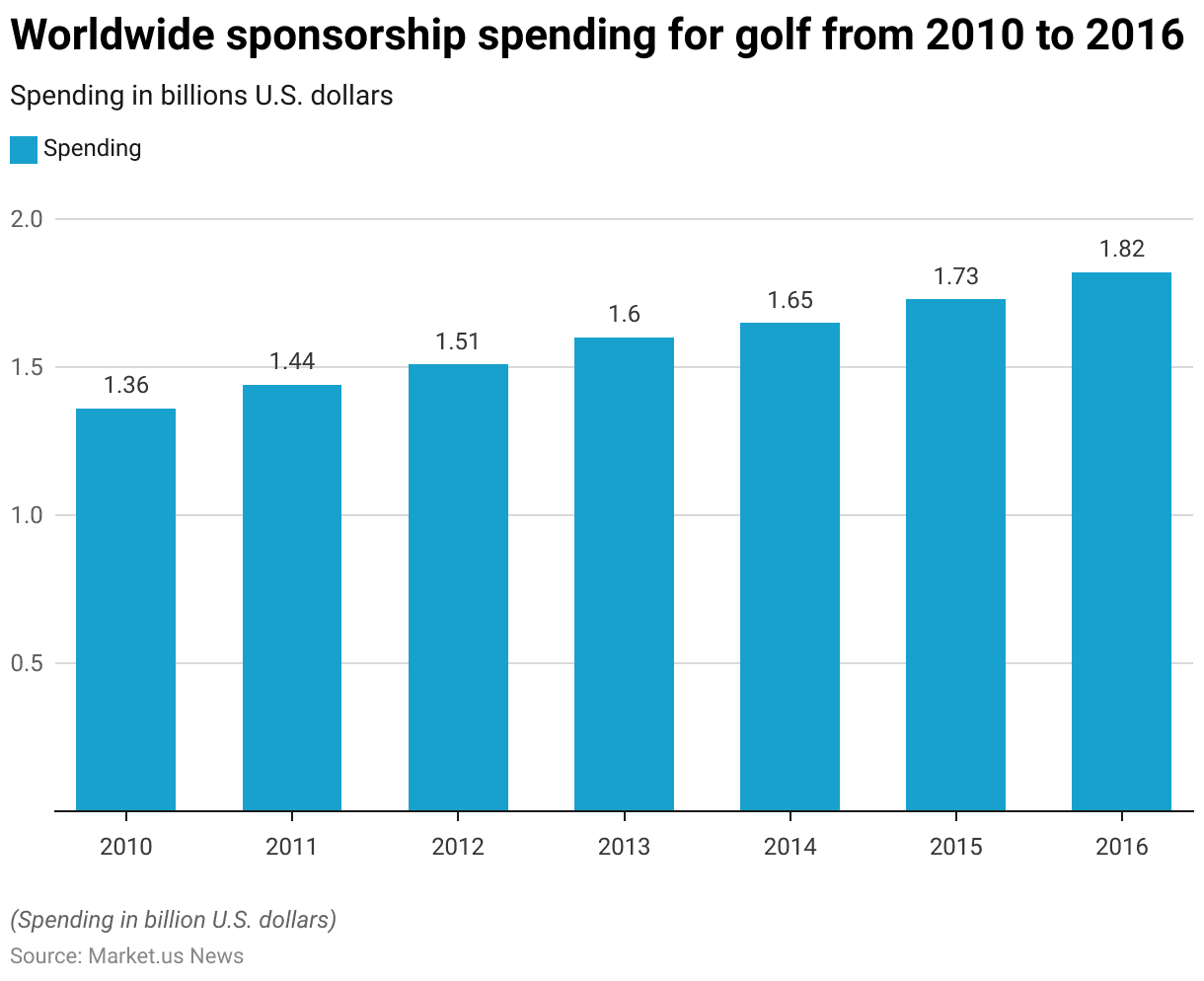
Regulations for Golf Balls
- Moreover, Golf ball regulations are primarily governed by the United States Golf Association (USGA) and the Royal and Ancient Golf Club of St Andrews (R&A). Ensuring consistency and fairness in the sport globally.
- According to these regulations, a standard golf ball must have a diameter of at least 1.68 inches (42.67 mm) and weigh no more than 1.62 ounces (45.93 grams). The ball must also be symmetrical and adhere to specific distance and velocity performance standards under controlled testing conditions.
- However, These regulations are universally recognized. This means a conforming golf ball in the United States will meet the same standards in other countries. Including those governed by the R&A in Europe and beyond.
- Advances in materials science are being applied to golf ball manufacturing. Including the use of graphene and other advanced polymers to enhance durability, distance, and control, providing better performance for players.
Discuss Your Needs With Our Analyst
Please share your requirements with more details so our analyst can check if they can solve your problem(s)





